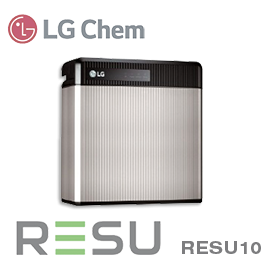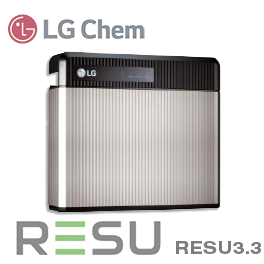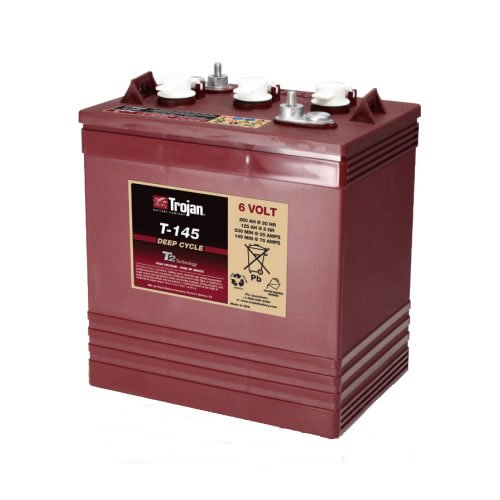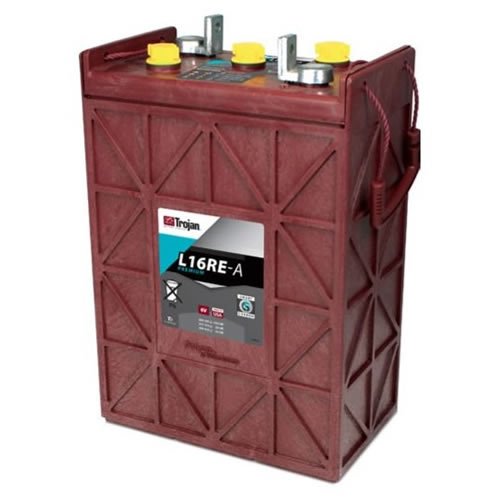Compare prices and reviews of the best solar battery banks in 2026
Updated: January 17, 2024Our expert and consumer reviews of the leading solar panel battery banks show the best solar batteries to suit your home in 2026
On this page:
Solar panel cost calculator
What is a solar battery?
A solar battery bank is simply a battery bank used to store excess solar electricity that is surplus to the power needs of your home at the time it is generated.
Solar batteries are important because solar panels only generate electricity when the sun is shining. However, we need to use power at night and at other times when there is little sun.
Solar batteries can turn solar into a reliable 24x7 power source. Battery energy storage is the key to allowing our society to transition to 100% renewable energy.
Energy storage systems
In most cases homeowners are no longer being offered solar batteries on their own they are being offered complete home storage systems. Leading products such as the Tesla Powerwall and the sonnen eco do contain a battery bank but they are much more than this. They also contain a battery management system, a battery inverter, a battery charger and also software based controls that allow you to control how and when these products charge and discharge power.
All of these newer all-in-one home energy storage and energy management systems use Lithium Ion battery technology and so if you have a home that is connected to the grid and are seeking a solar battery storage solution you no longer have to consider the question of battery chemistry technology. It was once the case that flooded lead acid battery technology was the most common solar battery bank for off grid homes but today there are no packaged home energy management solutions using lead acid batteries.
Why is lithium-Ion battery technology now so popular?
The core advantage of lithium ion battery technologies that have caused their almost uniform adoption in recent years is their higher energy density and the fact that they do not vent gases.
High energy density means they can store more power per cubic inch of space than the deep cycle, lead acid batteries that were traditionally used in off grid solar systems. This makes it easier to install the batteries in homes and garages with limited space. This is also the key reason they have been favoured for other applications such as electric cars, laptop batteries and phone batteries. In all of these applications physical size of the battery bank is a key issue.
Another important reason that lithium ion solar batteries are dominating is they do not vent toxic gases and so can be installed in homes. Older flooded lead acid deep cycle batteries that were traditionally used in off gird solar power systems did have the potential to vent toxic gases and so had to be installed in separate battery enclosures. In practical terms this opens up a mass market that was not there before with lead acid batteries. We feel this trend is now irreversible because all of the electronics and software to manage these home energy storage solutions is now being built to suit lithium ion battery technologies.
Are solar batteries worth it?
The answer to this question depends on four factors:
-
Do you have access to 1:1 net metering where you live;
1:1 net metering means that you get a 1 for 1 credit for each kWh of excess solar energy that you export to the public grid during that day. This means that if you design a solar system to cover 100% of your electric usage you will have no electric bill. It also means you don't really need a solar battery bank because the net metering law is allowing you to use the grid as your battery bank.
The exception to this is is where there is time of use billing and electric rates in the evening are higher than they are during the day (see below).
-
How much excess solar energy do you have to store in a battery?
There is no point having a solar battery unless you have a solar system that is big enough to generate excess solar energy during the middle of the day that can be stored in the battery. This is kind of obvious but it is something you need to check.
The exception to this is where there is time of use billing and electric rates in the evening are higher than they are during the day (see below).
-
Does your electric utility charge time of use rates?
If your electric utility has time of use electric billing such that power during the evening peak time is much more expensive than it is during the middle of the day then this can make the addition of an energy storage battery to your solar system more economic. For example if electricity is 12 cents during off peak and 24 cents during peak then each kW of solar energy you store in your battery will save you 12 cents.
-
Are there specific rebates for solar batteries where you live?
It is obviously much more attractive to buy a solar battery if part of the cost is going to be funded by some form of rebate or tax credit. If you are buying a battery bank to store solar energy then you can claim the 30% federal solar tax credit on it.
2.36 83 Reviews
Latest review
AD58,
over 1 month
Solar inverter (under warranty) went down. Set up service call - was going to be a week later, but with weather issues this time of year that seemed understandable. They just moved it two and a half weeks later, so now no solar for almost a month (assuming the tech doesn't need to order parts, which could add months to this). Meanwhile I'm paying their loan every month. You can't call them; it's automated attendant hell. There just is one way useless communication. Good solar system, worst customer service I've seen in years.
Read more
Average cost (5kW system)
$14,012 ($2.80 per watt)
Latest review
AD58, over 1 month
Solar inverter (under warranty) went down. Set up service call - was going to be a week later, but with weather issues this time of year that seemed understandable. They just moved it two and a half weeks later, so now no solar for almost a month (assuming the tech doesn't need to order parts, which could add months to this). Meanwhile I'm paying their loan every month. You can't call them; it's automated attendant hell. There just is one way useless communication. Good solar system, worst customer service I've seen in years.
3.93 4 Reviews
Latest review
Jake DiRe - CEO - EcoMark Solar,
over 1 month
EcoMark Solar has sold and installed over two dozen Sonnen units in Colorado! The entire EcoMark Solar team enjoys working with them. The product is easy to install, cutting edge, and all of our customers are very satisfied.
Read more
Average cost (5kW system)
$14,012 ($2.80 per watt)
Latest review
Jake DiRe - CEO - EcoMark Solar, over 1 month
EcoMark Solar has sold and installed over two dozen Sonnen units in Colorado! The entire EcoMark Solar team enjoys working with them. The product is easy to install, cutting edge, and all of our customers are very satisfied.
2.86 94 Reviews
Latest review
Adrianne,
over 1 month
My inverter has failed 3 times in 3 years. Each time, the “monitoring service” has failed to notice and it takes months to discover. The inverter has stopped working again and I cannot get a response from customer service. The website only provides DIY advice and the option to talk to a bot, which also malfunctioned. It has been 4 days and I still have not been able to contact a customer service rep. The are clearly avoiding their customers.
Read more
Average cost (5kW system)
$14,012 ($2.80 per watt)
Latest review
Adrianne, over 1 month
My inverter has failed 3 times in 3 years. Each time, the “monitoring service” has failed to notice and it takes months to discover. The inverter has stopped working again and I cannot get a response from customer service. The website only provides DIY advice and the option to talk to a bot, which also malfunctioned. It has been 4 days and I still have not been able to contact a customer service rep. The are clearly avoiding their customers.
3.75 1 Reviews
Latest review
Anonymous,
over 1 month
I work closely with the North American sales manager for BYD - Nicholas. When he comes to South Florida, I try to teach him Spanish and feed him good Cuban food.<br /><br />Because BYD is such a large company and has been around for so long (Warren BUffet invested in them) - I trust they will be there to help us if any support needs arise. It is helpful to go to one team of engineers for solar power and batteries.
Read more
Average cost (5kW system)
$14,012 ($2.80 per watt)
Latest review
Anonymous, over 1 month
I work closely with the North American sales manager for BYD - Nicholas. When he comes to South Florida, I try to teach him Spanish and feed him good Cuban food.<br /><br />Because BYD is such a large company and has been around for so long (Warren BUffet invested in them) - I trust they will be there to help us if any support needs arise. It is helpful to go to one team of engineers for solar power and batteries.
3.75 2 Reviews
Latest review
Anonymous,
over 1 month
This batteries rock, last easily 3-4 years in heavy usage (discharging and charging completelly once a day), specially if you use good charger controllers. They just relased some AGM solar ones, testing them now, lets see how they go, but they claim 8 years life... <br /><br />Always supersize the panels, they are way cheaper than batteries and keep batteries full all the time, also get a battery balancer that equalizes battery voltage, this helps a lot!
Read more
Average cost (5kW system)
$14,012 ($2.80 per watt)
Latest review
Anonymous, over 1 month
This batteries rock, last easily 3-4 years in heavy usage (discharging and charging completelly once a day), specially if you use good charger controllers. They just relased some AGM solar ones, testing them now, lets see how they go, but they claim 8 years life... <br /><br />Always supersize the panels, they are way cheaper than batteries and keep batteries full all the time, also get a battery balancer that equalizes battery voltage, this helps a lot!
Compare prices and reviews on all models of solar batteries
Average battery review score: 3.57
Average battery cost per kWh of usable storage: $883.28

Best unit price
$10,600
$785.19 per kWh
Table 1: POWERWALL overview
Type
Lithium-ion
Usable Energy (kWh)
13.50
Inbuilt Battery Inverter
Yes
Manufactured
US
Warranty (years)
10
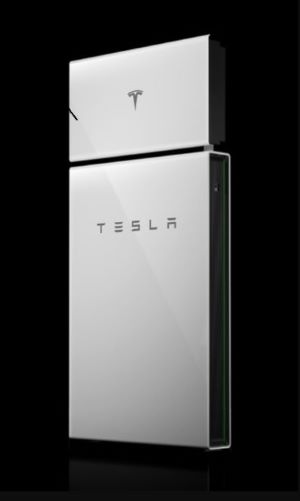
Table 1: POWERWALL+ 2 overview
Type
LITHIUM ION
Usable Energy (kWh)
14.00
Inbuilt Battery Inverter
YES
Manufactured
US
Warranty (years)
10
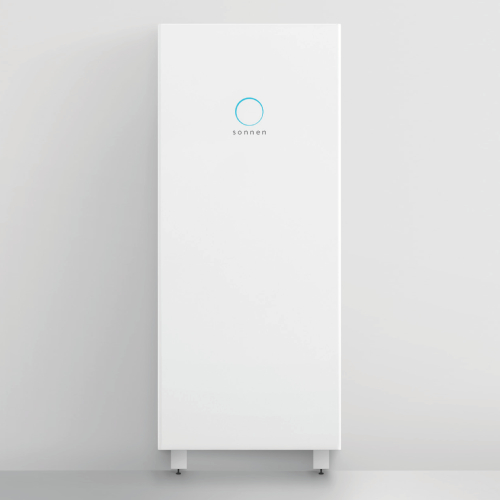
Table 1: SONNEN CORE+ 20 overview
Type
Lithium Iron Phosphate
Usable Energy (kWh)
20.00
Inbuilt Battery Inverter
Yes
Manufactured
US
Warranty (years)
10
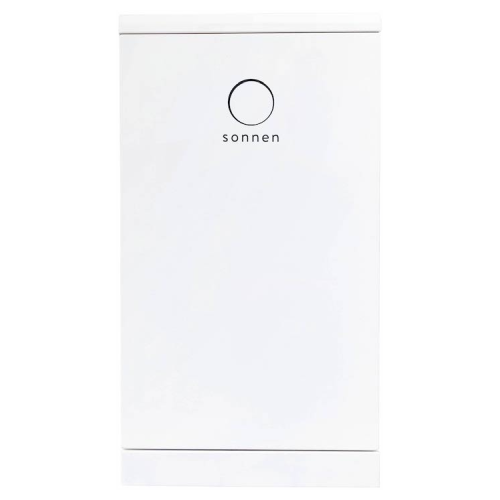
Table 1: SONNEN EVO overview
Type
LFP
Usable Energy (kWh)
10.00
Inbuilt Battery Inverter
Yes
Manufactured
US
Warranty (years)
10
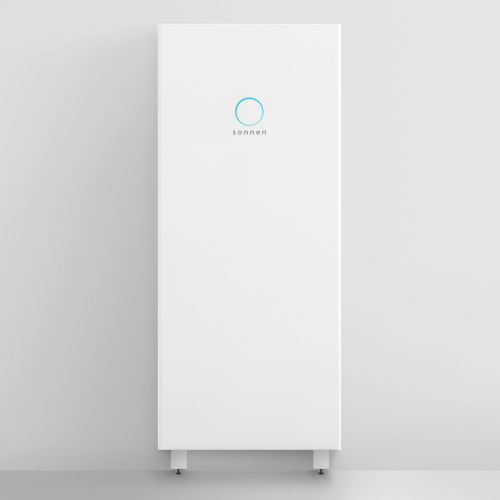
Table 1: SONNEN CORE+ 10 overview
Type
Lithium Iron Phosphate
Usable Energy (kWh)
10.00
Inbuilt Battery Inverter
Yes
Manufactured
US
Warranty (years)
10

Table 1: SOLAREDGE ENERGY BANK overview
Type
LITHIUM ION
Usable Energy (kWh)
10.00
Inbuilt Battery Inverter
NO
Warranty (years)
10

Table 1: A005KEEN261 overview
Manufactured
KR
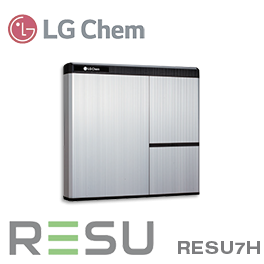
Table 1: LG CHEM RESU7H overview
Type
Lithium-ion
Usable Energy (kWh)
7.00
Inbuilt Battery Inverter
yes
Manufactured
KR
Warranty (years)
10
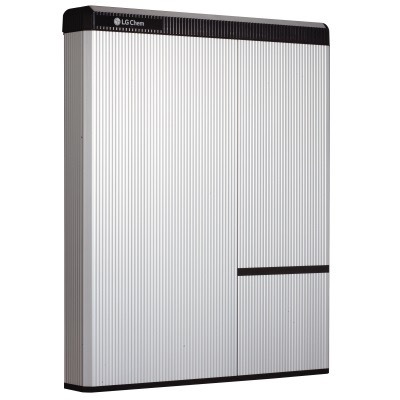
Best unit price
$7,000
$714.29 per kWh
Table 1: LG CHEM RESU10H overview
Type
Lithium-ion
Usable Energy (kWh)
9.80
Inbuilt Battery Inverter
yes
Manufactured
KR
Warranty (years)
10
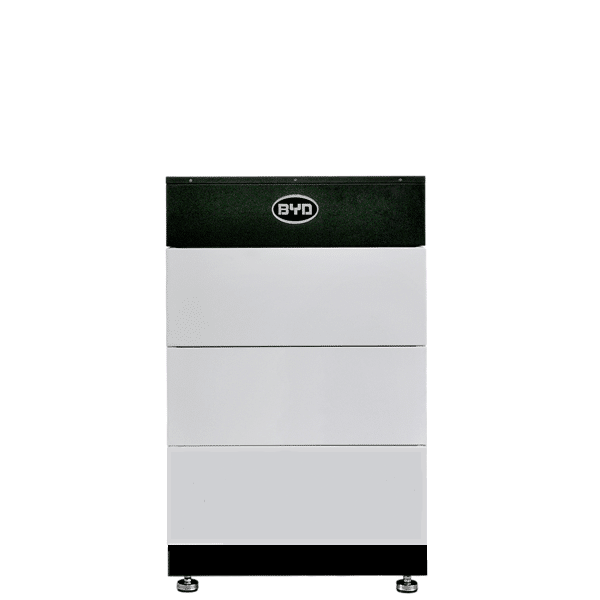
Best unit price
$11,360
$1,109.38 per kWh
Table 1: BATTERY-BOX H10.0 overview
Type
Lithium Iron Phosphate
Usable Energy (kWh)
10.24
Inbuilt Battery Inverter
Yes
Manufactured
CN
Warranty (years)
10
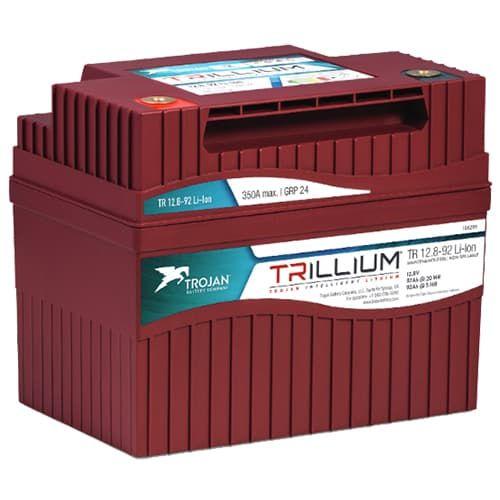
Best unit price
$1,294
$924.29 per kWh
Table 1: TR 12.8-110 LI-ION overview
Type
Deep-Cycle Lithium Iron Phosphate
Usable Energy (kWh)
1.40
Inbuilt Battery Inverter
No
Manufactured
US
Warranty (years)
8
Table 1: T-145 overview
Type
Flooded/wet lead-acid battery
Manufactured
US
Table 1: L16RE-A overview
Type
Flooded/wet lead-acid battery
Inbuilt Battery Inverter
No
Manufactured
US

Table 1: SAGM 06 315 overview
Type
Deep-Cycle solar AGM
Usable Energy (kWh)
1.89
Inbuilt Battery Inverter
No
Manufactured
US

Table 1: SAGM 06 375 overview
Type
Deep-Cycle solar AGM
Usable Energy (kWh)
2.25
Inbuilt Battery Inverter
No
Manufactured
US

Table 1: SAGM 08 165 overview
Type
Deep-Cycle solar AGM
Usable Energy (kWh)
1.32
Inbuilt Battery Inverter
No
Manufactured
US

Table 1: SAGM 12 135 overview
Type
Deep-Cycle solar AGM
Usable Energy (kWh)
1.62
Inbuilt Battery Inverter
No
Manufactured
US

Table 1: SAGM 12 205 overview
Type
Deep-Cycle solar AGM
Usable Energy (kWh)
2.46
Inbuilt Battery Inverter
No
Manufactured
US

Table 1: SIND 02 1990 overview
Type
Deep-Cycle Solar Flooded
Usable Energy (kWh)
3.98
Inbuilt Battery Inverter
No
Manufactured
US
Warranty (years)
10

Table 1: SIND 02 2450 overview
Type
Deep-Cycle Solar Flooded
Usable Energy (kWh)
4.90
Inbuilt Battery Inverter
No
Manufactured
US
Warranty (years)
10
AC-coupled vs DC-coupled solar batteries
Solar panels produce DC (direct current) electricity. Batteries charge and discharge DC electricity. Home appliances, however, use AC (alternating current) power.
Solar power systems with storage - that is, hybrid and off-grid systems - manage AC and DC power flows differently based on whether they’re using an AC-coupled battery or a DC-coupled battery.
Here’s how each type of battery system works:
AC-coupled batteries
In recent years, AC-coupled batteries have become the most popular battery solution for solar-plus-storage setups.
DC power is generated by the solar panels, and then converted to AC power by a standard grid-tie inverter. The resulting AC power can be used for multiple purposes: it can power the home, be exported to the grid, or be sent straight to an AC-coupled battery for storage.
This is possible because AC-coupled all-in-one battery storage systems contain electronics that:
- Convert incoming power from the grid-tie inverter from AC to DC
- Manage the charging and storage of DC power in the battery cells
- Convert outgoing (discharged) power back into AC for use in the home

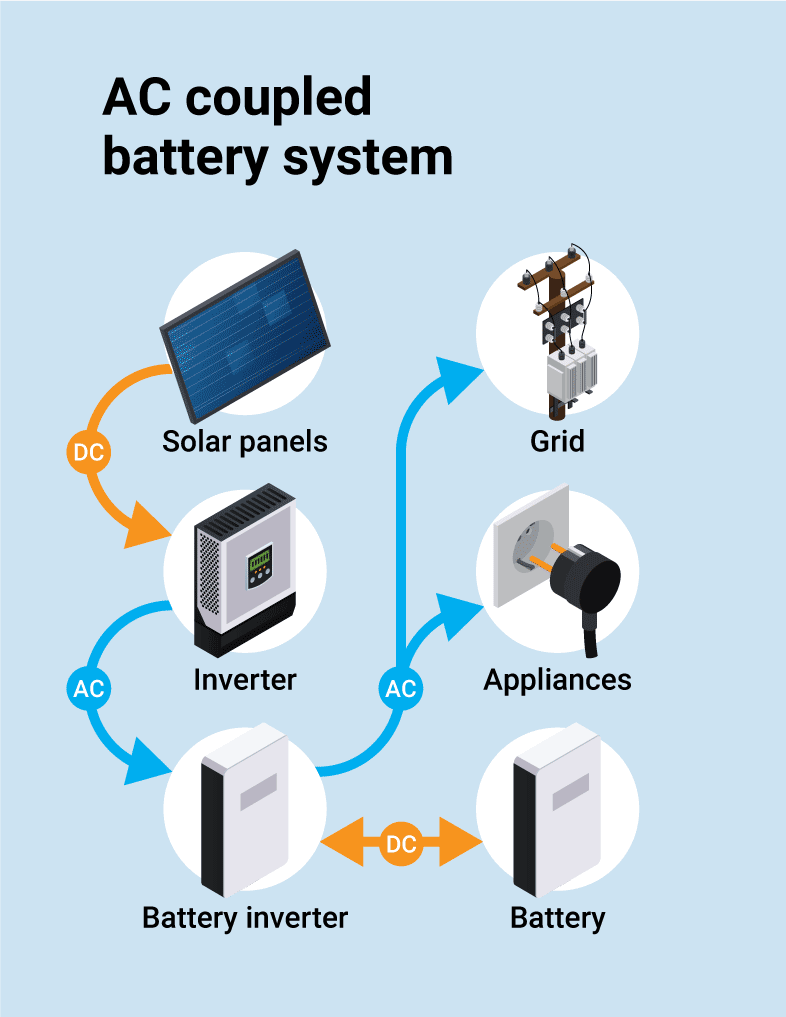
In an AC-coupled system, DC power from the solar panels is sent to the inverter for conversion.
All energy flows after that are in the form of AC power.
The Tesla Powerwall 2 and the sonnen eco — the two most popular solar battery solutions — use this AC-coupling method because it allows easy retrofitting to existing grid-tied solar systems.
Pro of AC-coupled battery: can be added to any grid-tied system without needing to change the existing setup and grid-tied inverter.
Con of AC-coupled battery: multiple conversions of power from DC to AC (and vice versa) results in higher efficiency losses.
DC-coupled batteries
This coupling method requires a charge controller to regulate the flow of DC power into the battery. A battery inverter is also needed to convert DC power flowing out of the battery into AC power so it can be used in the home. This is the coupling method used for traditional off-grid solar power systems.
Some market-leading DC coupled solutions, such as the StorEdge solution from SolarEdge, incorporate a charge controller into the battery inverter. Paired with a battery, such as the LG Chem RESU, this allows them to offer an all-in-one home energy storage solution similar to the AC-coupled Tesla Powerwall and sonnen eco.
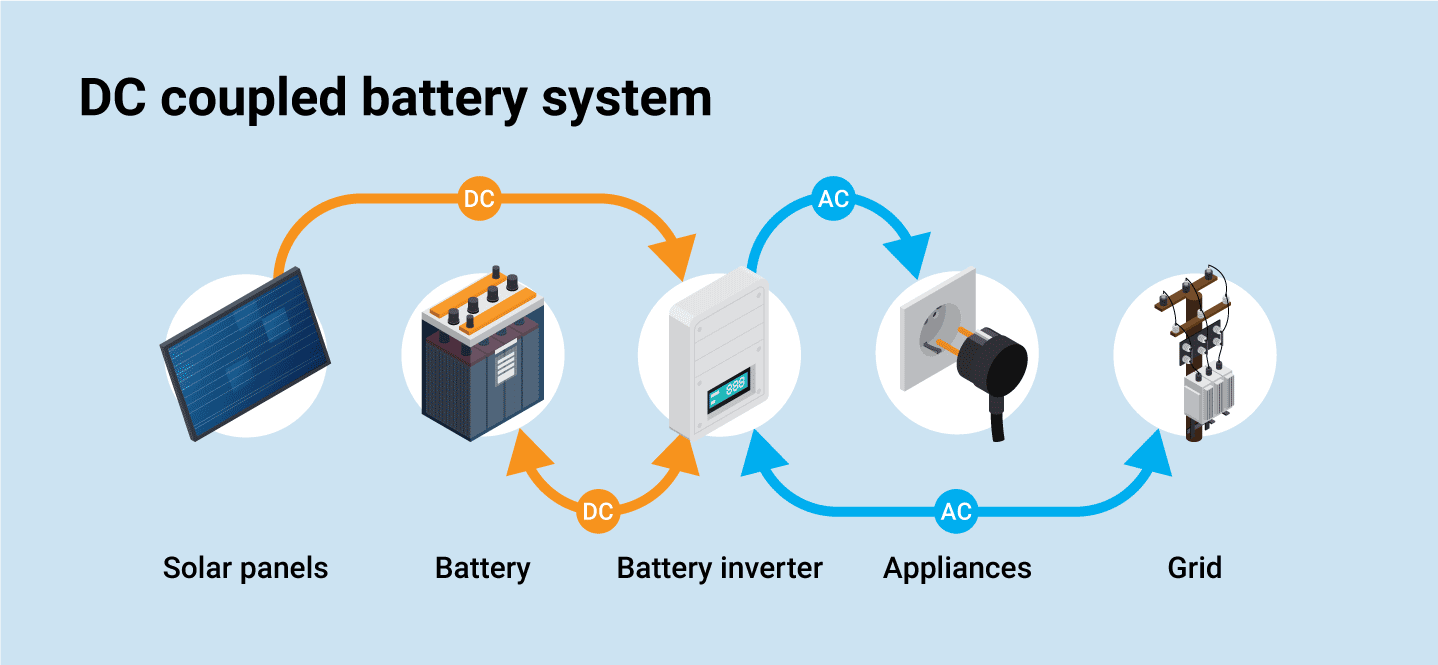
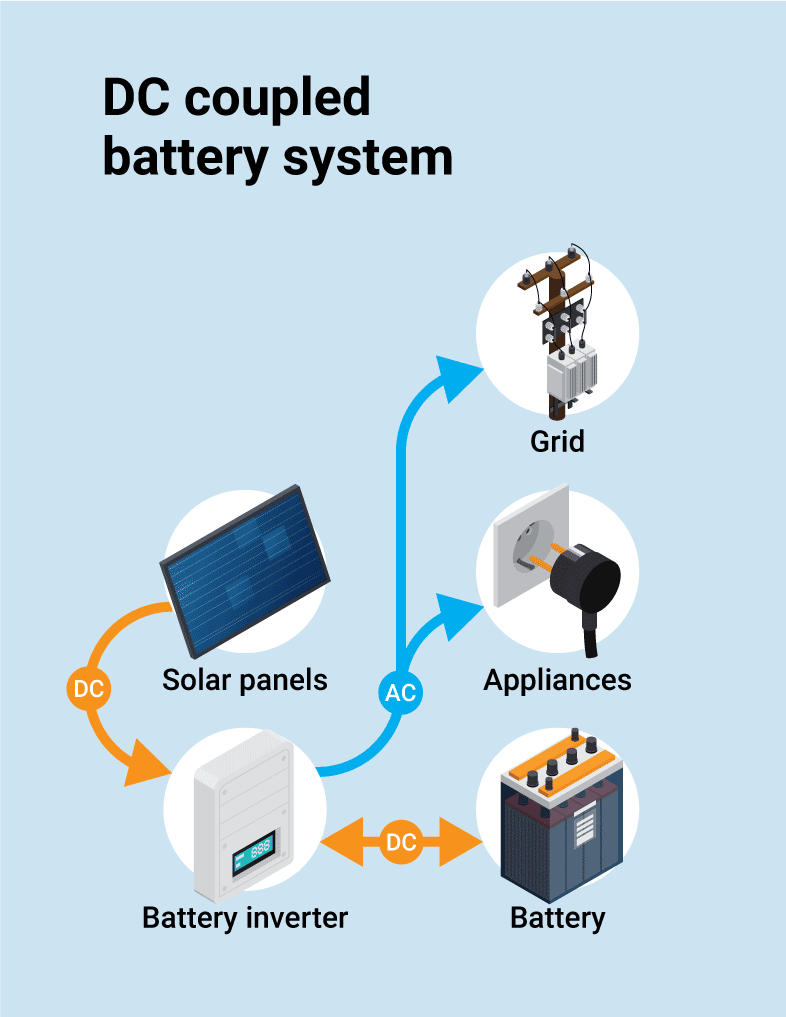
In a DC-coupled system, the inverter uses DC power from the solar panels to charge the DC battery.
Pro of DC-coupled batteries: lower power losses as there are fewer power inversions.
Con of DC-coupled batteries: to retrofit to existing grid-tied systems the grid tied inverter has to be compatible with the battery inverter.




